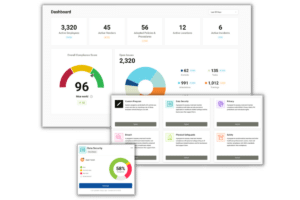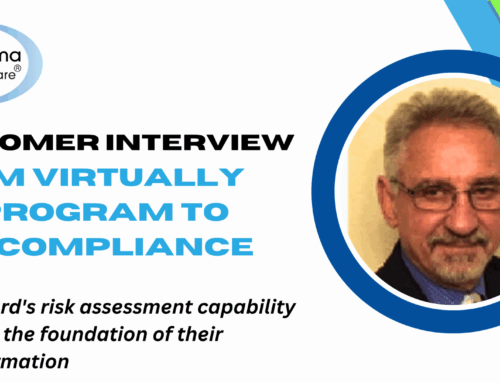
Healthcare data breaches have reached crisis levels. In the first seven months of 2025 alone, 444 large data breaches affecting 500 or more individuals were reported, representing a concerning upward trend. In June 2025, healthcare data breaches exposed the protected health information of over 7.6 million individuals, underscoring the urgent need for robust security measures.
As we observe Cybersecurity Awareness Month this October, the focus on “Building a Cyber Strong America” resonates particularly strongly within healthcare. This annual initiative, co-led by CISA and the National Cybersecurity Alliance, emphasizes the critical importance of protecting essential infrastructure—including healthcare systems that millions of Americans depend on daily for quality care, secure medical records, and life-saving services.
For healthcare organizations, understanding how to prevent healthcare data breaches isn’t just about regulatory compliance—it’s about protecting patient trust, avoiding devastating financial penalties, and ensuring the continuity of critical care services. This comprehensive guide provides actionable strategies backed by NIST and HHS research to fortify your organization’s cybersecurity posture.
Understanding the Healthcare Data Breach Landscape
Before implementing prevention strategies, it’s essential to understand the current threat environment facing healthcare organizations.
The Cost of Healthcare Data Breaches
Healthcare data breaches carry the highest financial burden of any industry. The average cost of a healthcare data breach consistently exceeds $10 million, with expenses including regulatory fines, legal fees, remediation costs, and long-term reputation damage. These financial consequences can cripple smaller healthcare providers and significantly impact larger health systems.
Primary Attack Vectors
Direct hacking and IT incidents are responsible for nearly 80% of all healthcare breaches, with system intrusion attacks—including malware, ransomware, and lateral movement—present in 53% of breaches. Understanding these attack patterns is crucial for developing effective prevention strategies.
The most common breach causes include:
Hacking and IT Incidents: Cybercriminals exploit vulnerabilities in network infrastructure, applications, and medical devices to gain unauthorized access to sensitive patient data.
Ransomware Attacks: Healthcare organizations face increasing ransomware threats that encrypt critical systems and data, demanding payment for restoration while potentially exfiltrating patient information.
Insider Threats: Employees or contractors with legitimate access may intentionally or accidentally cause data breaches through policy violations, negligence, or malicious activities.
Business Associate Vulnerabilities: Third-party vendors with access to protected health information (PHI) represent significant risk vectors, particularly when their security controls are inadequate.
Physical Security Failures: Lost or stolen devices, improper disposal of records, and unauthorized physical access continue to contribute to data exposure.
NIST Cybersecurity Framework for Healthcare
The National Institute of Standards and Technology (NIST) provides comprehensive guidance specifically tailored for healthcare cybersecurity. The NIST Cybersecurity Framework 2.0 offers a structured approach to managing and reducing cyber risks in healthcare environments.
The Five Core Functions
The NIST framework organizes cybersecurity activities into five core functions that work together to create comprehensive protection:
Identify: Develop organizational understanding to manage cybersecurity risk to systems, people, assets, data, and capabilities. This includes asset management, business environment analysis, governance establishment, risk assessment, and supply chain risk management.
Protect: Implement appropriate safeguards to ensure delivery of critical healthcare services. Protection activities include access control, data security, information protection processes, maintenance activities, and protective technology deployment.
Detect: Develop and implement activities to identify cybersecurity events promptly. Detection capabilities include anomaly detection, continuous security monitoring, and detection process establishment.
Respond: Take action regarding detected cybersecurity incidents. Response planning, communications, analysis, mitigation, and improvement activities ensure organizations can address threats effectively.
Recover: Maintain resilience plans and restore capabilities or services impaired by cybersecurity incidents. Recovery planning, improvements, and communications support timely restoration of normal operations.
Implementing NIST SP 800-66 Revision 2
NIST Special Publication 800-66 Revision 2 specifically addresses HIPAA Security Rule implementation, providing cybersecurity resource guidance for healthcare organizations. This publication bridges NIST’s comprehensive cybersecurity guidance with HIPAA’s specific requirements, helping organizations maintain confidentiality, integrity, and availability of electronic protected health information (ePHI).
HHS Cybersecurity Best Practices
The Department of Health and Human Services (HHS) has developed sector-specific cybersecurity guidance that complements NIST’s framework. The HHS Healthcare and Public Health (HPH) Sector Cybersecurity Framework Implementation Guide provides practical strategies for organizations of all sizes.
Risk-Based Approach
HHS emphasizes a risk-based approach to cybersecurity, recognizing that healthcare organizations vary significantly in size, resources, and risk profiles. This approach allows organizations to:
- Prioritize security investments based on actual risk levels
- Allocate limited resources to areas of greatest vulnerability
- Customize security controls to match organizational capabilities
- Demonstrate reasonable and appropriate security measures for compliance
Sector-Specific Considerations
Healthcare organizations face unique challenges that distinguish them from other industries:
Operational Continuity Requirements: Unlike many businesses, healthcare facilities cannot simply shut down systems during a security incident without potentially endangering lives.
Legacy System Challenges: Medical devices and health IT systems often remain in service far longer than typical IT equipment, creating persistent vulnerabilities.
Interconnected Ecosystem: Healthcare organizations share data with numerous partners, including other providers, insurers, laboratories, and pharmacies, expanding the attack surface.
Regulatory Complexity: Multiple overlapping regulations (HIPAA, HITECH, state laws) create compliance challenges that must be addressed alongside security concerns.
Essential Strategies to Prevent Healthcare Data Breaches
Implementing comprehensive breach prevention requires a multi-layered approach addressing technical, administrative, and physical security domains.
1. Implement Strong Access Controls and Authentication
Access control represents your first line of defense against unauthorized data access. NIST and HHS both emphasize the critical importance of robust identity and access management.
Multi-Factor Authentication (MFA): Require MFA for all access to systems containing ePHI. MFA significantly reduces the risk of credential-based attacks by requiring users to provide two or more verification factors. Deploy MFA for remote access, administrative accounts, and increasingly for all user access points.
Role-Based Access Control (RBAC): Implement RBAC to ensure users can only access information necessary for their specific job functions. This principle of least privilege limits damage if credentials are compromised and reduces insider threat risks.
Privileged Access Management: Establish special controls for accounts with elevated privileges. Use privileged access management solutions to monitor, control, and audit administrative activities. Limit the number of privileged accounts and require additional authentication for sensitive operations.
Regular Access Reviews: Conduct quarterly reviews of user access rights, promptly removing access for departed employees and adjusting permissions for role changes. Automated access governance tools can streamline this critical process.
2. Deploy Comprehensive Encryption
Encryption protects data both in transit and at rest, ensuring that even if unauthorized access occurs, information remains unreadable without proper decryption keys.
Encryption at Rest: Encrypt all devices and media containing ePHI, including servers, workstations, laptops, mobile devices, removable media, and backup systems. Full-disk encryption provides comprehensive protection against physical device theft or loss.
Encryption in Transit: Implement TLS 1.3 or higher for all network communications involving ePHI. This includes web traffic, email, file transfers, and communications with cloud services or business associates. Prohibit transmission of unencrypted ePHI over public networks.
Email Encryption: Deploy encrypted email solutions for communications containing patient information. Train staff to recognize when email encryption is necessary and provide user-friendly tools that don’t impede workflow.
Database Encryption: Implement database-level encryption with proper key management for systems storing large volumes of patient data. Consider transparent data encryption (TDE) for minimal performance impact.
3. Maintain Robust Network Security
Network security controls prevent unauthorized access and detect malicious activity before it can impact critical systems.
Network Segmentation: Divide your network into isolated segments to limit lateral movement if attackers gain initial access. Place medical devices, administrative systems, and guest networks on separate segments with controlled communication pathways.
Next-Generation Firewalls: Deploy advanced firewalls capable of deep packet inspection, intrusion prevention, and application-aware filtering. Configure firewalls to deny traffic by default, explicitly allowing only necessary communications.
Virtual Private Networks (VPNs): Require VPN connections for all remote access to organizational networks. Deploy zero-trust network access solutions that verify every access request regardless of location.
Wireless Network Security: Implement WPA3 encryption for wireless networks, deploy separate guest networks isolated from internal systems, and consider certificate-based authentication for enhanced security.
4. Establish Comprehensive Security Monitoring
Continuous monitoring enables rapid detection of security incidents, minimizing potential damage through swift response.
Security Information and Event Management (SIEM): Deploy SIEM solutions to aggregate, correlate, and analyze security logs from across your environment. Configure real-time alerts for suspicious activities such as unusual access patterns, failed login attempts, or data exfiltration indicators.
Intrusion Detection and Prevention Systems (IDS/IPS): Implement network-based and host-based intrusion detection to identify malicious activities. Modern IDS/IPS solutions use machine learning to detect novel attack patterns beyond signature-based approaches.
User and Entity Behavior Analytics (UEBA): Deploy UEBA tools that establish baselines of normal behavior and alert on anomalies. These solutions can detect insider threats and compromised credentials that bypass traditional security controls.
Regular Log Reviews: Establish procedures for regular security log analysis, even when automated systems don’t generate alerts. Human review often identifies subtle indicators of compromise that automated systems miss.
5. Develop and Test Incident Response Plans
Even with robust prevention measures, breaches may occur. Comprehensive incident response plans minimize damage and ensure regulatory compliance.
Incident Response Team: Establish a cross-functional team including IT security, legal, compliance, communications, and executive leadership. Clearly define roles, responsibilities, and decision-making authority for incident scenarios.
Response Procedures: Document detailed procedures for incident detection, containment, eradication, recovery, and post-incident analysis. Include specific steps for common scenarios like ransomware, credential theft, and insider threats.
Regular Testing: Conduct tabletop exercises quarterly and full-scale incident response simulations annually. Testing reveals procedural gaps and ensures team members understand their responsibilities during high-stress incidents.
Communication Plans: Develop templates and procedures for notifying affected individuals, regulatory agencies, law enforcement, and the media as required. Pre-draft communication materials to enable rapid response when time is critical.
Breach Notification Compliance: Understand HIPAA breach notification requirements, including the 60-day notification timeline for affected individuals and potential notification to HHS and media for large breaches.
6. Implement Comprehensive Patch Management
Unpatched vulnerabilities represent low-hanging fruit for attackers, making timely patching critical for breach prevention.
Automated Patch Deployment: Implement automated patch management solutions to deploy security updates systematically. Configure automatic installation for critical security patches during maintenance windows.
Prioritization Framework: Establish risk-based prioritization that addresses critical vulnerabilities in internet-facing systems and systems processing ePHI within 48-72 hours of patch availability.
Medical Device Patching: Develop specialized procedures for medical devices that cannot be patched immediately due to operational requirements or vendor restrictions. Implement compensating controls such as network segmentation and enhanced monitoring for vulnerable devices.
Virtual Patching: Deploy web application firewalls and IPS signatures to provide temporary protection when immediate patching isn’t feasible.
7. Secure Medical Devices and IoT
Connected medical devices introduce unique security challenges that require specialized approaches.
Device Inventory: Maintain a comprehensive inventory of all medical devices and IoT equipment, including device types, manufacturers, firmware versions, network connections, and data access patterns.
Network Isolation: Place medical devices on dedicated network segments with restricted access to other systems. Allow only necessary communications between medical devices and supporting IT systems.
Manufacturer Engagement: Work with device manufacturers to understand security capabilities, patch availability, and recommended security configurations. Incorporate security requirements into procurement contracts.
Continuous Monitoring: Deploy specialized medical device security solutions that monitor device behavior for anomalies without interfering with clinical functionality.
8. Manage Third-Party and Business Associate Risks
Business associates and vendors with access to ePHI extend your attack surface and require careful risk management.
Due Diligence Assessments: Conduct thorough security assessments before engaging business associates. Evaluate their security controls, incident response capabilities, and compliance history.
Business Associate Agreements (BAAs): Ensure comprehensive BAAs that clearly define security responsibilities, breach notification requirements, and your right to audit their security practices.
Ongoing Monitoring: Regularly reassess business associate security posture through questionnaires, security audits, and penetration testing results. Monitor for security incidents affecting your business associates.
Fourth-Party Risk: Understand that your business associates’ subcontractors also pose risks. Require business associates to maintain similar security standards with their vendors.
9. Invest in Security Awareness Training
Human error remains a leading cause of data breaches, making employee education essential for effective security. Cybersecurity Awareness Month each October provides an excellent opportunity to reinforce security practices and launch new training initiatives across your organization.
Regular Training Programs: Conduct comprehensive security awareness training upon hire and at least annually thereafter. Increase training frequency for high-risk roles with extensive ePHI access. Consider launching enhanced awareness campaigns during October to capitalize on the national focus on cybersecurity.
Phishing Simulations: Run regular simulated phishing campaigns to assess susceptibility and provide targeted training for users who fall victim to simulation attempts.
Role-Specific Training: Provide specialized training tailored to specific roles, such as IT administrators, clinical staff, and business office personnel who handle different types of sensitive information.
Incident Reporting Culture: Foster a culture where employees feel comfortable reporting potential security incidents without fear of punishment. Many breaches are detected by observant employees who notice something unusual.
Training Topics: Cover critical areas including password security, phishing recognition, mobile device security, clean desk policies, social engineering awareness, and proper handling of ePHI.
10. Conduct Regular Risk Assessments
HIPAA requires regular risk assessments, and NIST emphasizes continuous risk evaluation as fundamental to cybersecurity.
Comprehensive Risk Analysis: Conduct formal risk assessments at least annually, evaluating technical vulnerabilities, administrative gaps, and physical security weaknesses. Consider both internal and external threats.
Vulnerability Scanning: Implement automated vulnerability scanning for all systems, conducting scans at least monthly and after any significant system changes.
Penetration Testing: Engage qualified third parties to conduct penetration testing annually or after major infrastructure changes. Penetration testing simulates real-world attacks to identify exploitable vulnerabilities.
Risk Remediation: Develop risk management plans that prioritize identified vulnerabilities based on likelihood and impact. Document accepted risks with clear justification when immediate remediation isn’t feasible.
11. Backup and Disaster Recovery
Reliable backups serve as your last line of defense against ransomware and provide recovery options for various incident scenarios.
3-2-1 Backup Strategy: Maintain three copies of critical data on two different media types with one copy stored off-site. This approach ensures data availability even during catastrophic events.
Immutable Backups: Deploy backup solutions that create immutable copies that cannot be encrypted or deleted by ransomware. This capability has become essential given the prevalence of ransomware targeting backup systems.
Regular Testing: Test backup restoration procedures quarterly to verify data integrity and ensure recovery time objectives can be met. Document any issues and remediate promptly.
Air-Gapped Backups: Maintain offline, air-gapped backups for critical systems that remain disconnected from networks except during scheduled backup windows.
12. Physical Security Measures
While cyber threats dominate discussions, physical security remains crucial for comprehensive data protection.
Access Controls: Implement badge access systems for facilities and server rooms with audit logging. Limit access to areas containing ePHI to authorized personnel only.
Visitor Management: Establish procedures for escorting visitors, particularly in areas where they might access ePHI. Maintain visitor logs and ensure visitors return badges upon departure.
Workstation Security: Deploy privacy screens to prevent visual eavesdropping, implement automatic screen locks after short idle periods, and encourage clean desk policies.
Device Disposal: Establish procedures for secure disposal of devices and media containing ePHI. Use certified data destruction services that provide certificates of destruction.
Leveraging Cybersecurity Awareness Month
October presents a unique opportunity for healthcare organizations to strengthen their security culture and engage employees in meaningful ways.
Organize Awareness Activities: Use Cybersecurity Awareness Month as a catalyst for launching security initiatives. Host lunch-and-learn sessions, distribute educational materials, run security competitions, or invite external speakers to discuss emerging healthcare threats.
Secure Our World Campaign: Participate in CISA’s “Secure Our World” campaign by emphasizing four simple yet powerful actions: enable multi-factor authentication, use strong passwords, recognize and report phishing, and keep software updated. These fundamental practices prevent the majority of breaches when consistently applied.
Leadership Engagement: Encourage executive leadership to participate visibly in Cybersecurity Awareness Month activities. When leaders demonstrate commitment to security practices—from using MFA to attending training sessions—it reinforces the message that security is everyone’s responsibility.
Department-Specific Focus: Tailor awareness activities to different departments within your healthcare organization. Clinical staff need training on medical device security and patient data handling, while administrative staff should focus on email security and business associate communications.
Measurement and Recognition: Track participation in Cybersecurity Awareness Month activities and recognize departments or individuals who demonstrate exceptional security awareness. Positive reinforcement builds lasting cultural change more effectively than punitive approaches.
Creating a Culture of Security
Technical controls alone cannot prevent all breaches. Organizations must foster a culture where security is everyone’s responsibility.
Leadership Commitment: Executive leadership must visibly support cybersecurity initiatives through resource allocation, policy enforcement, and personal adherence to security practices.
Security Champions: Identify and empower security champions within departments who can promote security awareness and serve as local resources for security questions.
Incident Learning: When security incidents occur, conduct thorough post-mortems focused on learning rather than blame. Share lessons learned across the organization to prevent recurrence.
Continuous Improvement: Treat cybersecurity as an ongoing journey rather than a destination. Regularly assess and enhance security measures as threats evolve and technology changes.
Measuring Security Program Effectiveness
Establish metrics to evaluate your security program’s performance and identify improvement areas.
Key Performance Indicators (KPIs): Track metrics such as mean time to detect incidents, mean time to respond, percentage of systems with current patches, phishing simulation click rates, and security training completion rates.
Compliance Metrics: Monitor ongoing compliance with HIPAA Security Rule requirements, tracking completion of required assessments, training, and documentation updates.
Incident Trends: Analyze security incident patterns to identify recurring issues that require systemic improvements rather than individual incident remediation.
Benchmark Comparisons: Compare your organization’s security posture and incident rates against industry benchmarks to identify areas requiring additional attention.
Preventing Healthcare Data Breaches
Learning how to prevent healthcare data breaches requires a comprehensive approach combining technical controls, administrative safeguards, physical security measures, and a strong security culture. By implementing the strategies outlined in this guide—based on NIST and HHS research—healthcare organizations can significantly reduce their breach risk while meeting regulatory requirements.
As we recognize Cybersecurity Awareness Month this October, healthcare organizations have a unique opportunity to reinforce security priorities, engage staff in meaningful security conversations, and demonstrate commitment to protecting patient data. The theme “Building a Cyber Strong America” reminds us that healthcare cybersecurity isn’t just an organizational concern—it’s a national priority that affects everyone who depends on our healthcare system.
The threat landscape continues to evolve, with attackers developing increasingly sophisticated techniques. However, many breaches still result from fundamental security failures like unpatched systems, weak passwords, and inadequate employee training. By mastering the fundamentals while staying informed about emerging threats, healthcare organizations can protect patient data effectively.
Remember that cybersecurity is not a one-time project but an ongoing commitment requiring continuous assessment, adaptation, and improvement. Start with the basics, prioritize based on your organization’s specific risks, and progressively enhance your security posture. The investment in robust data breach prevention measures pays dividends through protected patient trust, avoided regulatory penalties, and ensured continuity of critical healthcare services.
For additional guidance, consult NIST Special Publication 800-66 Revision 2, the HHS Healthcare and Public Health Sector Cybersecurity Framework Implementation Guide, and our Practical Guide to Risk Assessment, which provide comprehensive, actionable recommendations tailored specifically for healthcare organizations.









